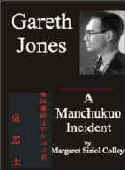Gareth Jones
[bas relief by Oleh Lesiuk]
HOME |
Stop Press |
Complete Soviet Articles & Background Information |
Précis of Gareth's
|
All Published Articles |
BOOKS
|
|
|
|
More Than Grain of Truth(2005) |
|
|
TOPICAL
'Are you Listening NYT?' U.N. Speech - Nov 2009 |
Gareth Recognised at Cambridge - Nov 2009 |
Reporter and the Genocide - Rome, March 2009 |
Order of Freedom Award -Nov 2008 |
Premiere of 'The Living' Documentary Kyiv - Nov 2008 |
Gareth Jones 'Famine' Diaries - Chicago 2008 |
Aberystwyth Memorial Plaque 2006 |
GENERAL
Scholarship Fund |
Site Map |
Links |
Legal Notices |
Sponsored Links |
Contact |
|
||
|
By Gareth Jones “HISTORY says -----,” Tom Morgan, Maindy, was speaking, and whenever Tom has some words of wisdom to utter in his overpowering Rhondda accent he always invokes history to bear out the truth of his statement. “History says that when King Edward the Confessor was in the Rhondda Valley, fleeing from his enemies, he hid in a barn near Pentre. There he lay listening to every sound. Then he heard the cry of the hounds. ‘Jawks,’ the King said, ‘it’s my butties from Cwmdar hunting.’ And he forgot all about his enemies, got on a horse and went galloping down towards Porth.” I have not delved sufficiently into the details of Edward the Confessor’s reign to vouch for the accuracy of Tom Morgan’s claim, but I am perfectly ready to believe that he is right in the spirit of his story. Had Edward the Confessor heard the beautiful call of the Bwllfa Hounds he would have cast aside the worries that tormented him, and, had he known Welsh, might have shouted ecstatically: “Heddi’ ydyw’ dydd i ddala Cadno
cyfrwys Craig-y-Bwllfa.” Have you seen this Craig-y-Bwllfa Crag where dwells “The cunning fox Of the Bwllfa Rocks”? Well, I have, and although I am not a hunting man (and I confess that I tremble when talking to hunting men for fear I drop some disgracefully unhunting phrase), I can see that sturdy hounds and sturdy huntsmen, too, are needed to face the perils of that country. “You’ll break your neck,” said Mr. W. M. Llewellyn, the Master, to me when I had reached Bwllfa, near Aberdare, to see his pack, and suggested mounting a pony. “These mountains contain big cracks caused by subsidence, for there are coal workings underneath. I’ve known rider and pony disappear from view in one of these cracks, and once we had a tragedy. A member of the hunting staff lost his way on the mountains, fell over a deep precipice, and was killed.” I looked at the steep crags where there was a perpendicular fall of several hundred feet. Ominous and black they looked, with the Bwllfa Colliery below and fleeces of white clouds above. Rocks jutted out here and there. Dangerous hunting country, indeed Even an innocent like myself could see that. So dangerous, indeed, that once in the Garw Valley, I was told, the whole pack, consisting of 52 hounds, after hunting for many miles, went to ground after the fox in an old coal level, and completely disappeared from view. There they were imprisoned, lost in the rambling corridors of the level. How could they ever be recovered? Mr. Llewellyn had an ingenious idea. He noticed that there was a current of air passing into the old mine. He thereupon purchased a number of old bloaters, and, hanging them up at the mouth of the drift, cooked them on the spot. The smell was drawn into the workings and half the hounds were attracted to the mouth of the mine. It took three weeks to recover 51 hounds and only one was lost. No sooner had I heard this than little dots of white, like snowflakes, ever darting along, suddenly appeared here and there, flashing against the blackness of the cliffs. It was the Pack. Then silhouetted against the sky, just like some bold rider on the yellow cover of a Zane Grey novel, stood the old huntsman, William Jones. Mr. W. M. Llewellyn and I stood fascinated by the never-stopping figures of the hounds seeking the scent. Although they were many hundreds of yards away the Master knew them all. “That’s Gwalia I There’s Gracious!” he cried. “See jealous Gwen!” Suddenly they burst into melody. “Listen to Playful and Remedy I They’ve got the best voices I” exclaimed Daniel Jenkins, Talsarn, an old blue-marked collier, who had just joined us. Off the hounds went in the direction of Mountain Ash, and soon nothing could be seen of them, although their music rang across the valley. “Your hounds have a wonderful history,” I said to Mr. Llewellyn. “Tell me about their past.” And this is the story I heard as the Master of the Foxhounds and I sat on a rock in the sunshine with the Glamorgan hills around us and the Brecon Beacons to the north. “I doubt,” said Mr. Llewellyn, “whether there is an older strain of Welsh hounds in existence, because they are direct descendants of the old Gelli Welsh foxhounds. The original hounds came from Sir Thomas Mansel, of Margam Abbey, in the seventeenth century, and contained the blood of the black and tan old Southern staghounds kept at Margam. The pack was for many years owned and hunted by the Jenkinses, Gelli, Cymmer, near Port Talbot, and was afterwards run by a committee of farmers living around Glyncorrwg and Port Talbot, and was under the mastership of Mr. Jenkin Jenkins, of Ynyscorrwg, who, at the age of 8o, still follows the Bwllfa Hounds. “In the year 1920 these hounds became my property and have their kennels at Nantmelyn Farm, Cwmdare, Aberdare.” “Have you done much to maintain the old Welsh breed, Mr. Llewellyn?” I asked. He replied: “Thanks to Mr. W. H. P. Rees, I have bred most of my hounds by crossing them with those of the Pantysgallog Hunt and they contain therefore the blood of the old Bediinog and Glog foxhounds. The pack also contains the strain of the old Tynewydd and Ystrad hounds and ate chiefly rough-coated, and lemon and white and black and tan in colour. They have a wonderful cry and I keep no mute hounds. “The district hunted by this pack is very large, covering more than zoo square miles, and contains such well-known rocks as Darren-y-Bwllfa, Craigy-Llyn, and Darren-y-Parc. The chief hunting centres are at Aberdare, Glyncorrwg, Maesteg, and Llangeinor, where there are separate kennels for the housing of the hounds.” Mr. Liewellyn then told me of his hunting coach, Mr. William Jones, chiefly known by followers of hunting in South Wales as “Bili o Rhiw,” who started his hunting career 63 years ago with the hounds of Mr. William Morgan, of Tremains, in the Ogmore Valley. It
was a hard life in the old days. He used often to ride, accompanied by Mr.
Tom Morgan, Maindy Farm, Pentre (who is also a keen supporter of the
Bwllfa Hounds), from Nantymoel, at the top of the With William Jones were two young men. I asked Mr. Llewellyn who they were. He replied: “One of them is Albert Reynolds, the huntsman, and the other is Thomas Reynolds, the whip. These young men are twins, and originally worked in one of my pits. I noticed their love for horses and other animals. So I took them to the kennels, where they were taught the art of hunting by William Jones.” Thus two ex-miners are huntsman and whip, and among the followers are many of the boys of the Bwllfa Colliery, as well as the hill-farmers. It is a real Welsh democratic community, where they hunt in Welsh and sing of the chase in Welsh. In the Bwllfa Hunt there lives on the spirit of the song “Helfa Ilangynwyd” and of the stirring poem by Alun which I read first as a boy: “Daliwyd, daliwyd, daliwyd yma, Gadno cyfrwys Craig-y-Byllfa.” September 18th, 1933 |
GARETH JONES (1905 -35) |




